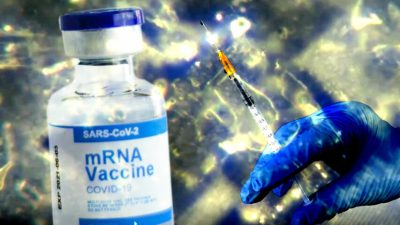by Paul Anthony Taylor, Global Research:

On the outer edges of the World Wide Web, it isn’t difficult to find people making outlandish claims about ingredients contained in the mRNA and DNA forms of COVID-19 vaccines. As a science-based organization, while strongly disputing assertions that these injections are supposedly proven to be ‘safe’, our Foundation steers a strict course well clear of such speculation. A few days ago, however, an interesting article in the Australian edition of The Spectator, a mainstream British magazine focusing on politics, culture, and current affairs, came to our attention. Authored by journalist Rebecca Weisser, it describes how when examining droplets from the Pfizer mRNA vaccine under a dark-field microscope, Dr. David Nixon, a Brisbane GP, observed what appear to be mechanical arms assembling and disassembling glowing rectangular structures resembling circuitry and microchips. Captured on video, what Nixon filmed is certainly thought-provoking, to say the least.
TRUTH LIVES on at https://sgtreport.tv/
As The Spectator article describes, the structures Nixon observed in the droplets of vaccine he examined seemed motionless at first. It was only when using time-lapse photography, condensing hours of footage into minutes, that the structures’ movement was revealed. Nixon says the formation of crystals in the droplets seems to be stimulated by electromagnetic radiation, and that this stops when the slide containing the vaccine is shielded by a Faraday bag (a container made from a conducting material that blocks external electromagnetic fields from reaching its interior). The Spectator article suggests Nixon’s findings are similar to those made by other teams from New Zealand, Germany, Spain, and South Korea.
Nixon has apparently shared what he saw with Wendy Hoy, Professor of Medicine and Director of the Centre for Chronic Disease at the University of Queensland in Australia. Recognized internationally for her multidisciplinary research and work in kidney and related chronic disease, Hoy has reportedly called on the Australian government and its health authorities to explain the apparent spontaneous formation of chips and circuitry in mRNA vaccines, and the abnormal objects that are claimed to have been seen in the blood of vaccinated people. It will be interesting to see what response she gets.
Mounting controversy
Nixon’s findings seemingly heap still further controversy on the mRNA and DNA forms of vaccines used against COVID-19. Serious side effects now attributed to the injections include severe liver damage; very low platelet counts (thrombocytopenia); high rates of severe, potentially life-threatening allergic reactions (anaphylaxis); inflammation of the heart muscle (myocarditis); blood clots (thrombosis); and even death. With analysis by British Medical Journal senior editor Peter Doshi and colleagues showing the Pfizer and Moderna mRNA COVID-19 vaccines are statistically more likely to cause serious adverse events than they are to prevent hospitalization, it is long since time that their use should have been suspended.
Do Nixon’s bizarre videos really show mechanical arms assembling and disassembling circuitry and microchips? Frankly, without further evidence, it is impossible to say for sure. But whatever the structures filmed by Nixon are, one thing seems for sure in that the controversy surrounding mRNA- and DNA-based COVID-19 vaccines is unlikely to disappear anytime soon.
While the Dr. Rath Health Foundation does not necessarily support the analysis contained in this video, we are sharing it in the public interest towards the goal of encouraging a wider debate on the subject of COVID-19 vaccines.
*
Note to readers: Please click the share buttons above. Follow us on Instagram and Twitter and subscribe to our Telegram Channel. Feel free to repost and share widely Global Research articles.




